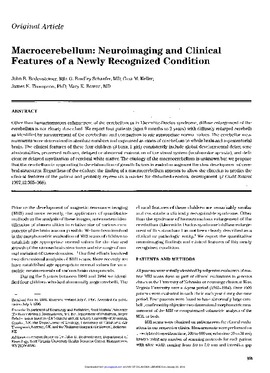| dc.contributor.author | John B. Bodensteiner | |
| dc.contributor.author | G. Bradley Schaefer | |
| dc.contributor.author | Gina M. Keller | |
| dc.contributor.author | James N. Thompson | |
| dc.contributor.author | Mary K. Bowen | |
| dc.date.accessioned | 2016-01-14T19:53:15Z | |
| dc.date.accessioned | 2016-03-30T15:31:50Z | |
| dc.date.available | 2016-01-14T19:53:15Z | |
| dc.date.available | 2016-03-30T15:31:50Z | |
| dc.date.issued | 1997-09-01 | |
| dc.identifier.citation | Bodensteiner, J. B., Schaefer, G. B., Keller, G. M., Thompson, J. N., & Bowen, M. K. (1997). Macrocerebellum: Neuroimaging and Clinical Features of a Newly Recognized Condition. Journal of Child Neurology, 12(6), 365-368. doi: 10.1177/088307389701200605 | en_US |
| dc.identifier.uri | https://hdl.handle.net/11244/25145 | |
| dc.description.abstract | Other than hamartomatous enlargement of the cerebellum as in Lhermitte-Duclos syndrome, diffuse enlargement of the cerebellum is not clearly described. We report four patients (ages 9 months to 2 years) with diffusely enlarged cerebelli as identified by measurement of the cerebellum and comparison to age appropriate normal values. The cerebellar measurements were determined in absolute numbers and expressed as ratios of cerebellum to whole brain and supratentorial brain. The clinical features of these four children (3 boys, 1 girl) consistently include global developmental delay, tone abnormalities, preserved reflexes, delayed or abnormal maturation of the visual system (oculomotor apraxia), and deficient or delayed myelination of cerebral white matter. The etiology of the macrocerebellum is unknown but we propose that the cerebellum is responding to the elaboration of growth factors intended to augment the slow development of cerebral structures. Regardless of the etiology, the finding of a macrocerebellum appears to allow the clinician to predict the clinical features of the patient and probably represents a marker for disturbed cerebral development. (J Child Neurol 1997;12:365-368). | en_US |
| dc.language.iso | en_US | en_US |
| dc.publisher | Journal of Child Neurology | |
| dc.title | Macrocerebellum: Neuroimaging and Clinical Features of a Newly Recognized Condition | en_US |
| dc.type | Research Article | en_US |
| dc.description.peerreview | Yes | en_US |
| dc.description.peerreviewnotes | https://us.sagepub.com/en-us/nam/manuscript-submission-guidelines | en_US |
| dc.identifier.doi | 10.1177/088307389701200605 | en_US |
| dc.rights.requestable | false | en_US |
